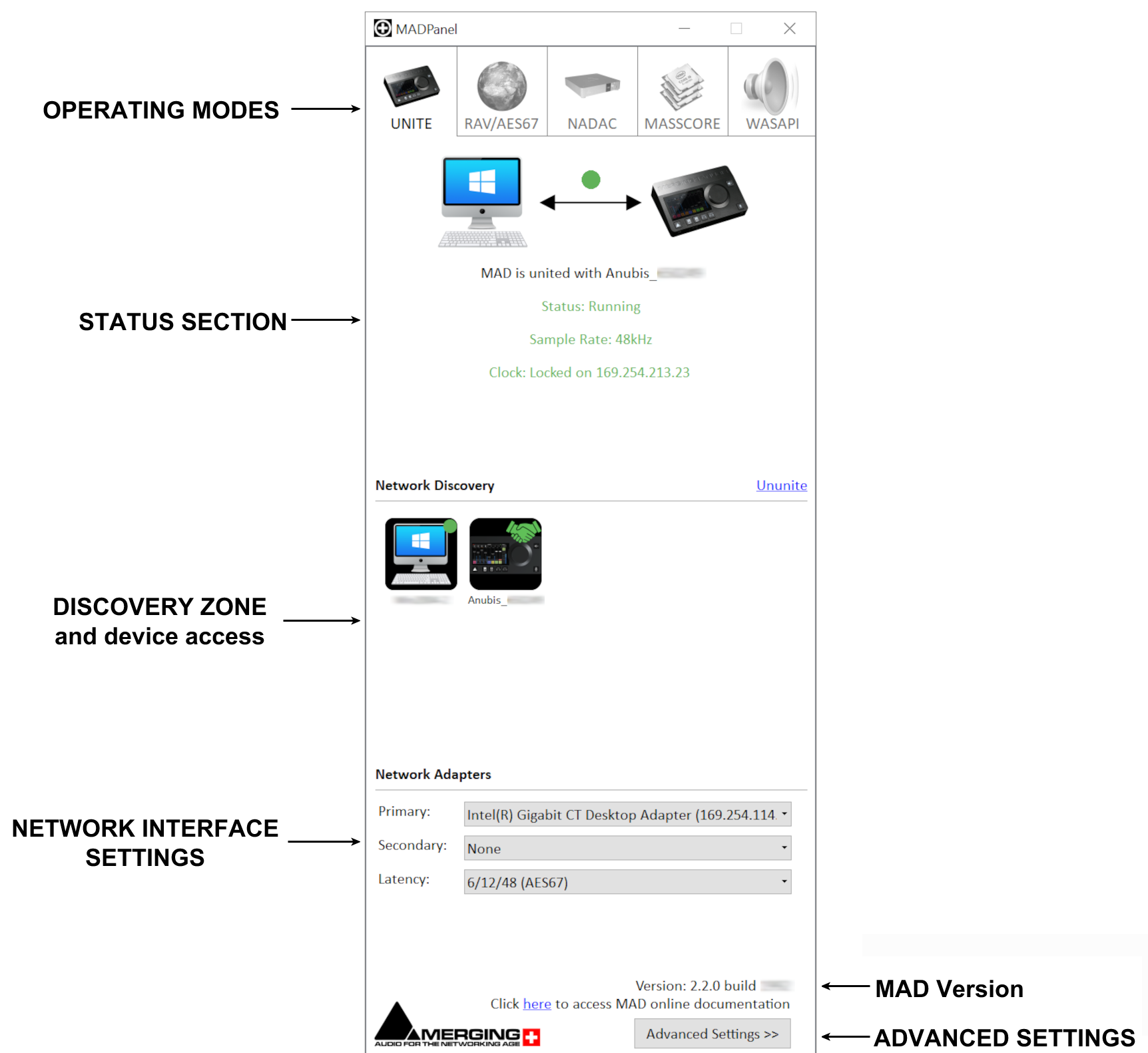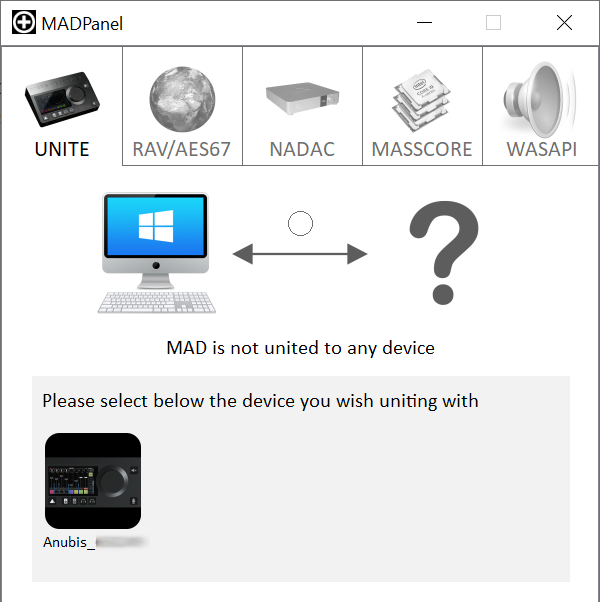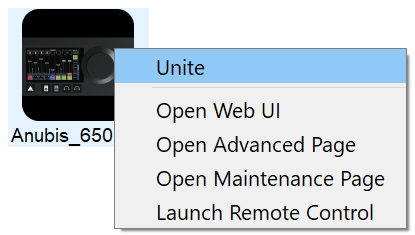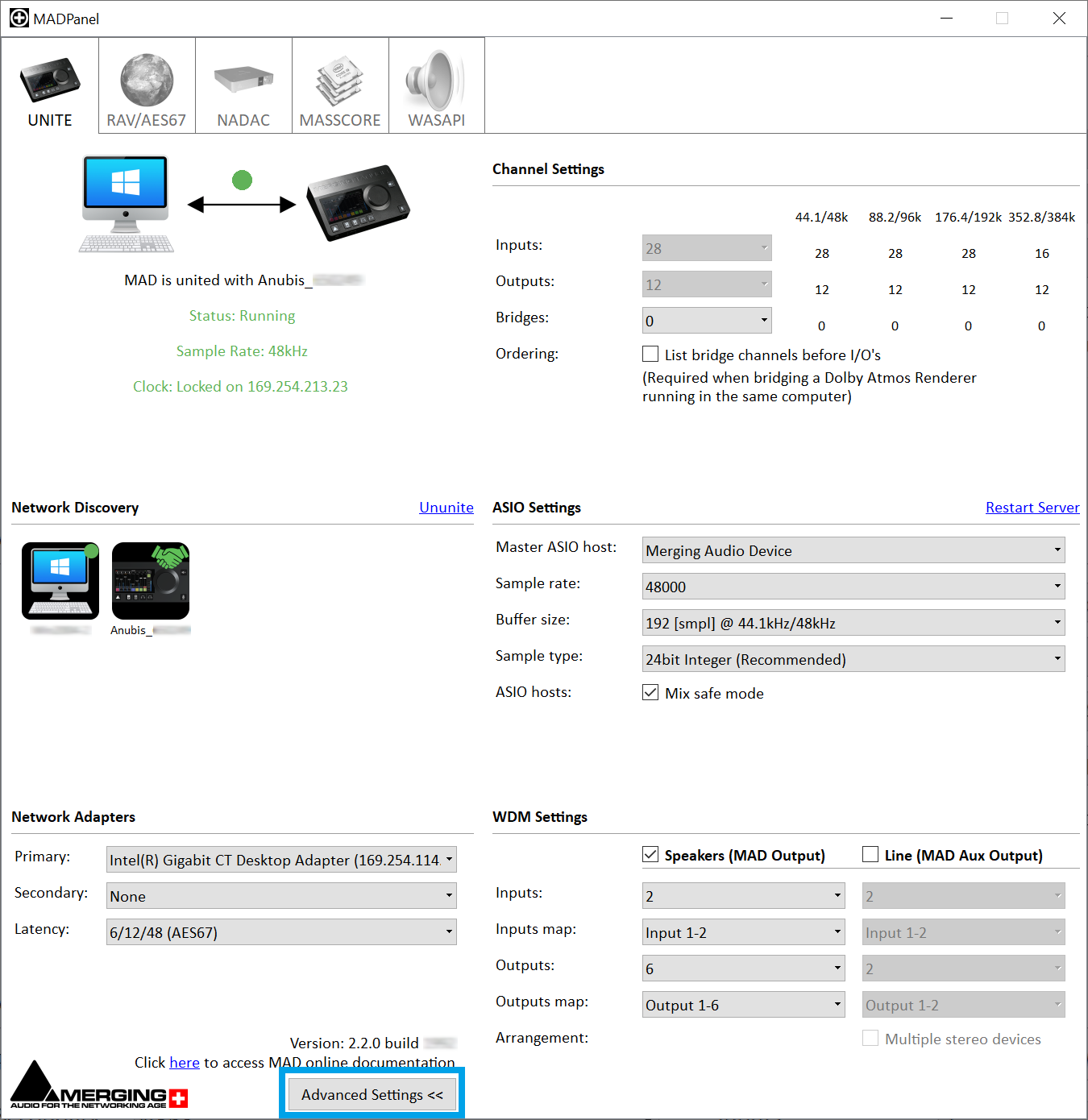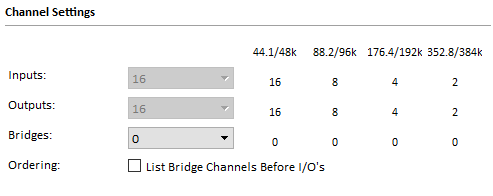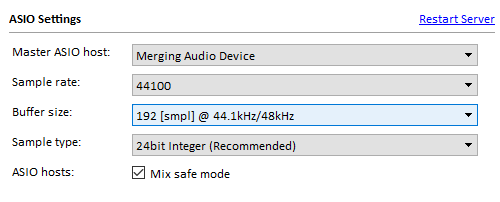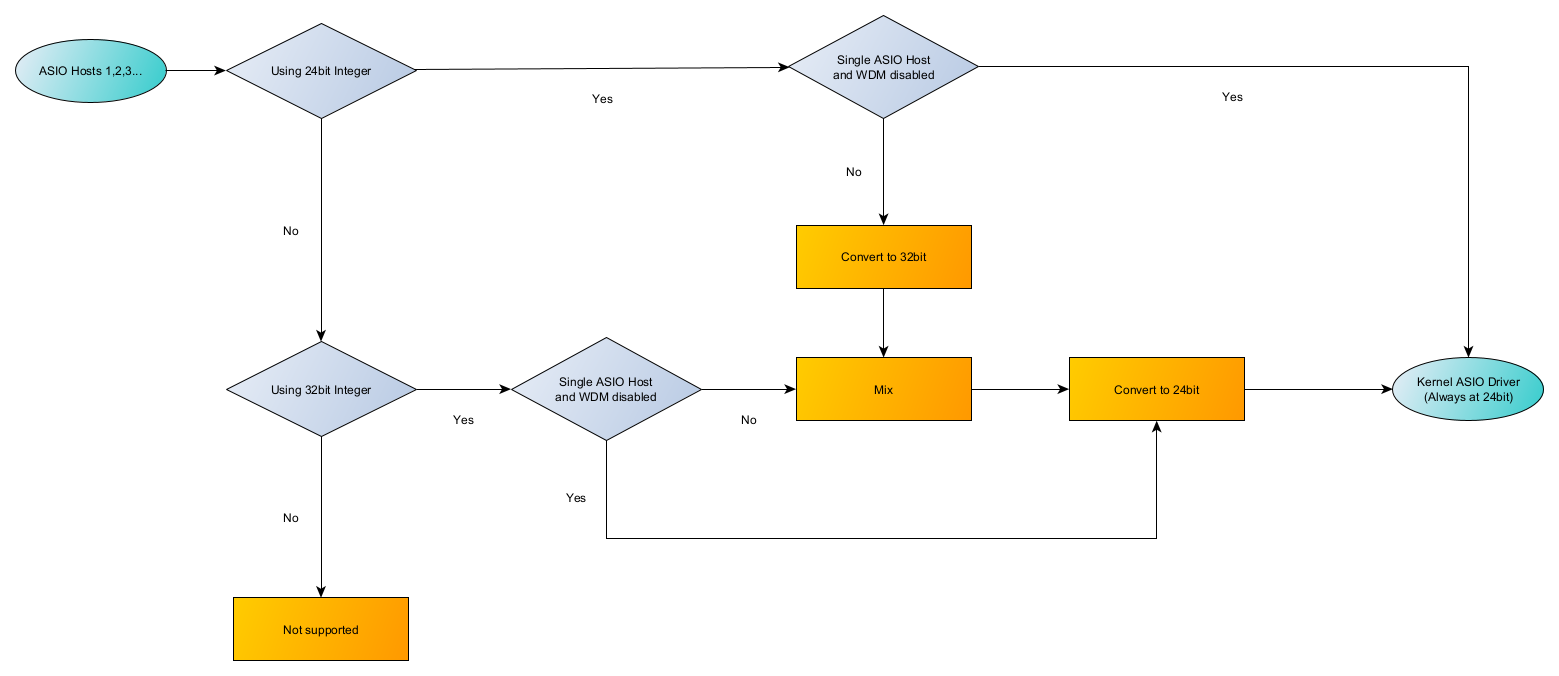Merging Audio Device panel settings.
MODES
- UNITE
UNITE is simplified an automatic AoIP Stream patching mode that allows a user with a mouse click to connect all IO between the Anubis and the System/Driver
Refer to the UNITE page for more details - RAV/AES67
Provides full control over your AoIP RAVENNA/AES67 streams connections, using ANEMAN Audio NEtwork MANager. Preferred mode to run multiple devices such as Horus, Hapi, Anubis.
Refer to the RAV/AES67 page for more details - NADAC
Dedicated mode to run the Merging+NADAC device, with pre-configured settings. - MassCore
Dedicated mode for MassCore configuration.
Refer to the MassCore page for more details. - WASAPI
WASAPI allow you to use your WDM Audio Device, instead of AES67/RAVENNA devices.
Refer to the WASAPI page for more details.
STATUS SECTION
The status section will inform you of the current state of your network and device state, such as streams status, sampling rate and PTP clocking.
The section also provides device connectivity tools and error messages reports. Refer to the UNITE or RAV/AES67 mode for more details.
- Driver
Current ASIO driver sampling rate. It may differ from the sample rate set in your DAW or your device. - State
Should be "Running". If "no ASIO Host connected" is displayed, please refer to the Merging Audio Device Troubleshooting page. - Clock
Shows the current ASIO PTP Master Clock device IP - Sampling Rate - PTP Domain - Network Latency - Solution
Tips on how to solve the reported error
NETWORK DISCOVERY ZONE
The devices discovered on your RAVENNA/AES67 network are displayed in this section.
- To access Merging devices web apps, advanced pages or firmware update, right click on the device icon.
NETWORK INTERFACE SETTINGS
- Primary adapter
Lists all available network ports. Select the network adapter your Merging RAVENNA/AES67 device is connected to. - Secondary adapter
Allows ST2022-7 running mode (redundancy).
This feature requires a 2022-7 license. Without this license, the setting is unavailable.
Note: ST2022-7 is not compatible with the Unite mode. Please use RAV/AES67 mode. - Latency
Select the Frame mode in use ; AES67 based on 6/12/48 samples (default) or RAVENNA based on 16/32/64 samples.
Your devices all have to be on the same frame mode multiples.
Note: Latency setting is only available in RAV/AES67 mode
ADVANCED SETTINGS
Expand the Advanced Settings from the bottom of the MAD Panel
Channel Settings
- Inputs and Outputs
The maximum number of Inputs and Outputs available are 128 @1Fs, 64 @2Fs, 32 @4Fs and 16 @8Fs.
In Unite mode, the number of inputs and outputs is automatically set. - Bridge Channels
Dedicated Internal MAD channels, that allows routing between applications.
Details on how to configure and use the bridge channels available in the MAD Use cases.
Note : All ASIO channels will use some bandwidth and CPU processing even if not connected to RAVENNA/AES67 devices.
Don't set it to 128 if you only need 8 ! - List Bridge Channels Before I/O's
When enabled it changes the published IO channel Layout, puttin the Bridge channels before the IO channels.
Some application are restrictive in their IO layout and do not allow conventional IO routing. Typically the Dolby Atmos Renderer will require that you enable this List Bridge Channel option.
ASIO Settings
- Master ASIO Host
Allows to set a Master application, that will act as a Master sampling rate device.
This list is dynamically populated, the first time you start an application set to use the Merging Audio device, it will be added to the list.
When a Master ASIO host is set, other applications cannot change the sampling rate.
Default : any application can change the sampling rate any time.
Merging Audio Device : the sampling rate is set from the panel Sample Rate setting. ASIO applications cannot change the sampling rate.
Please note that DSD Sampling rates cannot be set in that mode.
Application : Only the application set as Master ASIO Host can modify the sampling rate.
Important notes on ASIO Host and Sample rate :
Some applications may not support sampling rate change while running, refer to the manufacturer for details.
Changing the sampling while recording / playing back will obviously create drops, do not change the sampling rate during crucial real-time operations.
For further details on sample rate configurations, please see this page.
Windows WDM cannot be set as Master ASIO Host. - Sample rate
Allows to set the sampling rate, if the Master ASIO Host is set to Merging Audio Device, or if the Master ASIO Host set is not started. - Buffer size
In 48 (AES67) Framing mode, buffer sizes available are 768 - 384 - 192 (default) - 96 - 48 samples (based on 1Fs 44.1/48 kHz)
In 64 (RAVENNA) Framing mode, buffer sizes available are 1024 - 512 - 256 - 128 - 64 samples (based on 1Fs 44.1/48 kHz)
A buffer size of 192 (AES67) or 256 (RAVENNA) samples is recommended, usually stable value for all available sampling rates. Sample type
The internal Audio Engine can be set to 24bit Integer (default) or 32 bit integer (some ASIO hosts are only compatible with 32 bit integer)
Note : this setting only applies to the internal audio engine, and not to the RAVENNA/AES67 network, which currently supports 24bit Integer only. Therefore the physical inputs and outputs are not affected by this setting.
The WDM to ASIO bridge also supports 24 bit only.
DSD sampling rates do not allow 32bit sample type, MAD will automatically switch to 24 when running such sampling rate.- Mix safe mode
Mixes the different ASIO nodes with an extra processing buffer.
Disabling Mix safe mode will reduce the ASIO latency when one application is using the Merging Audio device.
The counterpart is that you may also get a drop / glitch, especially when you start and run several applications using MAD.
WDM Settings
- Speakers (MAD Output)
Enable / disable MAD as a Windows Speakers sound device. Typically useful to those wishing to monitor system sound such as YouTube, Spotify, Playback system audio file...
Note: On some systems, the speakers layout is not properly recalled by Windows (after a computer restart for example). This issue is currently under investigation.
In such case, the user should reapply the speakers layout in Windows Control Panel > Sound Control Panel. - Configure. - Line (MAD AUX Output)
Enable / disable MAD as a Windows Line sound device. - Inputs / Outputs
Sets the number of inputs / outputs in the MAD Windows sound device.
Note for the Speakers output: - Inputs / Outputs Map
Map the WDM channels into the MAD channels.
Details on how to configure and use the WDM bridge available in the MAD Use cases. - Arrangement - Multiple stereo devices
Multiple Stereo MAD WDM sound devices, instead of a multichannel one. Only active on the AUX output and if more than 2 inputs or outputs are set.
Note : all WDM devices will run at the same sampling rate.
Additional features
Displays the installed Merging Audio Device Version
Opens the Merging Audio Device online documentation (internet connection required).
Restarts the ASIO driver.
WARNING : Restarting the ASIO server will completely stop any audio, and some DAW may crash. Only use in case of issues !
Notes
- If you have a dedicated network adapter for RAVENNA / AES67 network, please see the optimized adapter configuration page.
- In case of issues, please consult the Merging Audio Device Troubleshooting page.
- Tip : You can configure Windows Taskbar to always show the Merging Audio Device panel and Aneman icons.
Right click on the Taskbar and click on Taskbar settings.
In the Notification area section, click on Select which icons appears on the taskbar.
You can then select which icons you want to have displayed.
